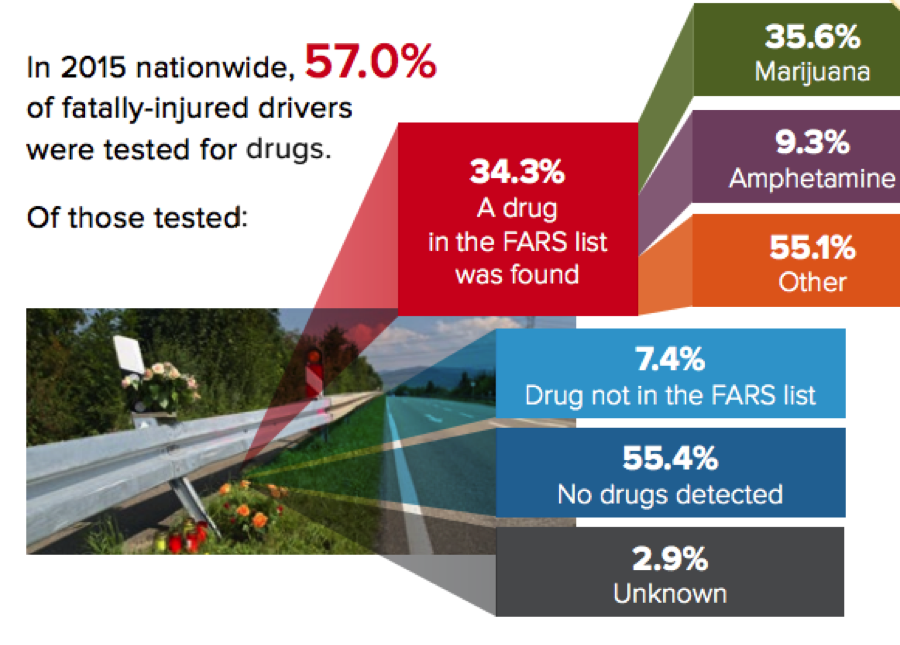February 23, 2018
It has long been understood that there are three main factors that lead to most traffic deaths: alcohol, speeding, and not wearing a seatbelt. But as more states begin to allow medical and recreational marijuana use, and the opioid epidemic continues to devastate many American communities, a fourth category has emerged: driving under the influence of drugs (DUID).
According to a report from Governors Highway Safety Association and the Foundation for Advancing Alcohol Responsibility, alcohol was present in 37 percent of fatal collisions in 2015. Surprisingly, drugs (illegal and prescription) were found to be involved in even more traffic fatalities: 43 percent.
Out of those cases, marijuana was the most frequently detected drug in fatally injured drivers’ bloodstreams.

(Asst. Editor’s note: DUID, in case there was any doubt, is against the law in all 50 states and Washington, D.C.)
This countrywide issue led the National Highway and Traffic Safety Administration (NHTSA) to launch its Drugged Driving Initiative last month under Deputy Administrator Heidi King. The initiative seeks to address issues that are unique to drugged driving, which is much more difficult to detect than behaviors like drunk driving, speeding, and not wearing a seat belt.
Unlike the three aforementioned factors, it is difficult to both visually identify and test for DUID.
The swerving motions of drunk drivers, for example, are a dead giveaway; spotting someone without a seatbelt is hardly difficult; and law enforcement officers have been catching and ticketing speeders since 1899. But drivers under the influence of marijuana or opioids may not exhibit the same behaviors.
Even after a driver is pulled over, there is not yet a reliable or quick method for law enforcement to test for drugs. Marijuana use, for example, does not easily lend itself to tests of recent use. Universities like Stanford have been researching methods for immediate detection of marijuana by testing saliva, dubbed the “potalyzer”.
While saliva tests for marijuana and other drugs have the potential to be as prevalent and accurate as breathalyzers are now, they have been criticized for having wide detection windows that may cause a person to test positive even if they are not under the influence at the time.
Blood and urine testing are not an option for roadside tests either, for a wide range of logistical and privacy reasons. Even if blood testing were an option, THC (the main psychoactive component in marijuana) is unlike alcohol in that it can stay in the bloodstream for days after consumption, well after its effects have worn off. Complicating issues further, recent studies have shown that there is no correlation between impairment and blood THC levels. A heavy marijuana user could test positive for THC in their bloodstream even if they were not intoxicated while driving.
As a result, saliva tests appear to be the best solution for the time being. Law enforcement agencies in Michigan and California are now starting to use saliva tests for drugs including marijuana, opiates, and cocaine.
But detection is just one piece of the puzzle. Law enforcement cannot catch every person who gets behind the wheel while under the influence of drugs – but NHTSA can work with government and advocacy partners to influence public perception of drugged driving and the risks involved.
To a large extent, building social pressure has already worked to reduce drunk driving, thanks to the efforts of Mothers Against Drunk Driving (MADD) and safety advocates since the 1980s.
But the focus on driving under the influence has largely centered on alcohol – with a lesser focus on drugs. Making matters worse, drugged driving historically has not garnered nearly as much attention as drunk driving among research institutions. The effects of marijuana and opioids on the human body itself have been studied for decades, but researchers are now working to close the gap in research about how they actually impact one’s ability to drive.
For this reason, USDOT’s initiative will review best practices for detecting drugged driving – and how to prevent it from happening in the first place. Since there is not a widely agreed-upon method for detecting whether a driver is under the influence, USDOT will conduct research of roadside screening methods in order to inform how law enforcement agencies can respond to, and reduce, drugged driving.
NHTSA maintains a resource page for drugged driving on its website, and the next step in this initiative will begin with a summit on March 15. Since there are so many unanswered questions about drug use and driving, the summit will explore opportunities and methods to prevent DUID.
The agency has called on a wide range of stakeholders to contribute to the effort, including representatives of the safety community, state/local policymakers, and industry.




